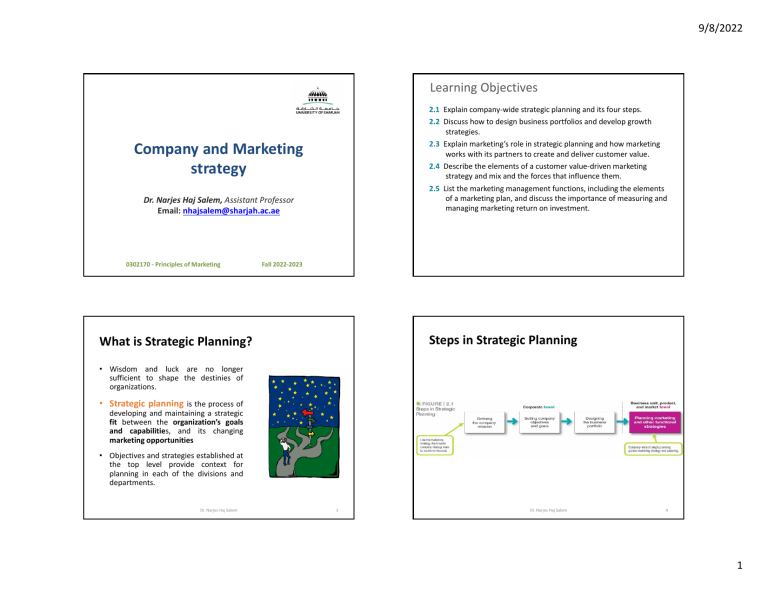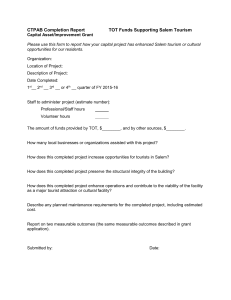
9/8/2022 Learning Objectives 2.1 Explain company‐wide strategic planning and its four steps. 2.2 Discuss how to design business portfolios and develop growth strategies. 2.3 Explain marketing’s role in strategic planning and how marketing works with its partners to create and deliver customer value. 2.4 Describe the elements of a customer value‐driven marketing strategy and mix and the forces that influence them. 2.5 List the marketing management functions, including the elements of a marketing plan, and discuss the importance of measuring and managing marketing return on investment. Company and Marketing strategy Dr. Narjes Haj Salem, Assistant Professor Email: nhajsalem@sharjah.ac.ae 0302170 ‐ Principles of Marketing Fall 2022‐2023 Steps in Strategic Planning What is Strategic Planning? • Wisdom and luck are no longer sufficient to shape the destinies of organizations. • Strategic planning is the process of developing and maintaining a strategic fit between the organization’s goals and capabilities, and its changing marketing opportunities • Objectives and strategies established at the top level provide context for planning in each of the divisions and departments. Dr. Narjes Haj Salem 3 Dr. Narjes Haj Salem 4 1 9/8/2022 Mission statement 1. Defining a Market‐Oriented Mission • A mission statement should: • Organization exists to accomplish something purpose should be clearly stated: This X 1. Not be myopic in product terms ( we make and sell furniture); but market oriented ( Discover and save creative ideas; Pinterest is the world’s catalog –What is our business? of ideas) –Who is the customer? 2. Be meaningful and specific; –What do consumers value? 3. Be motivating; –What should our business be? • The mission statement is the organization’s purpose; what it wants to accomplish in the larger environment. 4. Emphasize the company’s strengths; Give people a window into the world’s information wherever it might be found 5. Contain specific workable guidelines; 6. Not be stated as making sales or profits; profits are only reward for creating value. Dr. Narjes Haj Salem 5 Dr. Narjes Haj Salem 6 Examples of mission statement Product‐ versus Market‐Oriented Business Definitions Company Product‐Oriented Definition Market‐Oriented Definition Starbucks We sell coffee and snacks. We sell “The Starbucks Experience,” one that enriches people’s lives in one moment, one human being, one extraordinary cup of coffee at a time. Panera We sell fast‐casual food in our restaurants. We give customers “Food as it should be”: food that tastes good; food that feels good; food that does good things for them and the world around them. • Almarai : To provide quality and nutritious food & beverages that enrich consumers’ lives every day. • Unilever : “to add vitality to life. We meet everyday needs for nutrition, hygiene and personal care with brands that help people feel good, look good and get more out of life.” • Intel : Utilize the power of Moore's Law to bring smart, connected devices to every person on earth • Boeing: Connect, Protect, Explore and Inspire the World through Aerospace Innovation • Twitter: To give everyone the power to create and share ideas and information instantly, without barriers.” © Dr. Narjes Haj Salem 8 2 9/8/2022 Airbnb’s Mission 2. Setting Company Objectives and Goals Belong Anywhere–Don’t Stay There. Live There. ‐ Heinz’s owns a variety of brands, with a same mission: ‐ “As the trusted leader in nutrition and wellness, Heinz is dedicated to the sustainable health of people” ‐ Vision: “ To be the best food company, growing a better world” H.J. Heinz Company 3. Designing the Business Portfolio Setting Company Objectives and Goals Business objectives The business portfolio is the collection of businesses and products that make up the company. Marketing objectives • Build profitable customer relationships “superior in quality, taste, nutrition, and convenience” • Invest in research • Improve profits Dr. Narjes Haj Salem • The best business portfolio is the one that best fits the company’s strengths and weaknesses to opportunities in the environment. • Increase market share • Create local partnerships • Increase promotion • Example: GE business portfolio: GE Aviation, GE Capital, GE Energy, GE Home & Business Solutions, GE Global Research, GE Health Care, GE Technology Infrastructure. 11 Dr. Narjes Haj Salem 12 3 9/8/2022 Practice 3. Designing the Business Portfolio • Visit the website of these companies and find their business portfolio: • Business portfolio planning involves two steps. 1. The company must analyze its current business portfolio and determine which businesses should receive more, less, or no investment. – Mars – Agthia – Unilever.com 2. It must shape the future portfolio by developing strategies for growth and downsizing. Dr. Narjes Haj Salem 13 Analyzing the Current Business Portfolio Dr. Narjes Haj Salem 14 Analyzing the Current Business Portfolio Growth‐share matrix is a portfolio‐planning method that evaluates a company’s SBUs in terms of market growth rate and relative market share. Identify strategic business units (SBUs) Assess the attractiveness of its various SBUs Decide how much support each SBU deserves SBU can be a: Company division, Product line within a division; Single product or brand Dr. Narjes Haj Salem 15 Dr. Narjes Haj Salem 16 4 9/8/2022 Analyzing the Current Business Portfolio • Stars are high-growth, high-share businesses or products requiring heavy investment to finance rapid growth. They will eventually turn into cash cows. • Cash cows are low-growth, high-share businesses or products that are established and successful SBUs requiring less investment to maintain market share. • Question marks are low-share business units in high-growth markets requiring a lot of cash to hold their share. • Dogs are low-growth, low-share businesses and products that may generate enough cash to maintain themselves but do not promise to be large sources of cash. Strategies • Difficulty in defining SBUs and measuring market share and growth • Time consuming • Expensive • Focus on current businesses, not future planning The Boston Consulting Group Approach Dr. Narjes Haj Salem Developing Downsizing Problems with Matrix Approaches for 17 Growth and Market penetration involves making more saleslooks to current customers without •Product Product/market expansion grid atproducts newmarkets products, Market development involves identifying and developing new for offering modified or new to current Diversification involves starting up or buying businesses beyond its current products changing its original product such as by adding new stores in current market products, new markets, and existing its existing current products (new segments or new geographic markts.markets for markets such as by moving into new product categories. andareas markets. to make it easier for customers to visit. company growth opportunities. Existing products Product/market expansion grid • Market penetration: involves making more sales to current customers without changing its original product. – E.g., Adding new stores in current market areas to make it easier for customers to visit. • Market development involves identifying and developing new markets for its current products. New products – Managers could review new demographic markets and target them. – Managers could consider new geographic. Existing markets • Product development involves offering modified or new products to current markets such as by moving into new product categories. • Diversification involves starting up or buying businesses beyond its current products and markets. New markets – The company could acquire a company that operates in different market segments with a different product mix. Dr. Narjes Haj Salem 19 Dr. Narjes Haj Salem 20 5 9/8/2022 Developing Strategies for Growth and Downsizing Example: Starbucks • Downsizing is when a company must prune, harvest, or divest businesses that are unprofitable or that no longer fit the strategy. • Many reasons for downsizing: – Company may have grown too fast or entered areas where it lacks experience. – The market environment might change, making some products or markets less profitable. – Some products or business units simply age and die. Dr. Narjes Haj Salem 22 Steps in Strategic Planning Examples ‐downsizing • P&G : sold Folgers, Sunny Delight, Pringles. • GM: pruned Oldsmobile, Pontiac, Hummer and Saab. Dr. Narjes Haj Salem 23 Dr. Narjes Haj Salem 24 6 9/8/2022 Planning Marketing: Partnering to Build Customer Relationships Partnering with Other Company Departments Planning Marketing: Partnering to Build Customer Relationships Partnering with Other in the marketing system • Marketing alone can’t create superior customer value. Under the company‐wide strategic plan, marketers must work closely with other departments to form an effective internal company value chain. • The firm needs to look beyond its own value chain and into the value chains of its suppliers, distributors, and ultimately, customers. • Value chain is a series of departments (marketing, finance, accounting, HR, purchasing) that carry out value‐creating activities to design, produce, market, deliver, and support a firm’s products. • The firm’s success depends not only on how well each dep. performs its works but also on how all the various department coordinate their activities. Marketing Strategy and the Marketing Mix • More companies today are partnering with other members of the supply chain to improve the performance of the customer value delivery network. • Increasingly, today’s competition no longer takes place between individual competitors. Rather, it takes place between the entire value‐delivery networks created by these competitors. Customer Value‐Driven Marketing Strategy • Market segmentation is the division of a market into distinct groups of buyers who have different needs, characteristics, or behaviors and who might require separate products or marketing mixes. • Market segment is a group of consumers who respond in a similar way to a given set of marketing efforts. • Marketing strategy is the marketing logic by which the company hopes to create customer value and achieve profitable customer relationships. • Which customers will we serve ? & How will we create value for them? 7 9/8/2022 Customer Value‐Driven Marketing Strategy • Market targeting is the process of evaluating each market segment’s attractiveness and selecting one or more segments to enter. • A company might decide to serve: • only one or a few special segments or market niches, segments that major competitors overlook or ignore. • E.g.: Ferrari; Etihad Airways (luxury air) • several related segments—perhaps those with different kinds of customers but with the same basic wants. • E.g.: Gap Inc: Gap, Banana Republic, Old Navy, Intermix • all market segments, offering a complete range of products. • E.g.: Toyota : Yaris, Camry, Rav5, Fj Cruiser Developing an Integrated Marketing Mix Customer Value‐Driven Marketing Strategy Market positioning is the arranging for a product to occupy a clear, distinctive, and desirable place relative to competing products in the minds of target consumers. – – – – – Audi: “ Truth in Engineering” Subaru: “ Confidence in motion” Coke: “ Open happiness” Pepsi: “live for now” Adidas: “Noting is impossible” Differentiation (begins the positioning process): differentiating the market offering to create superior customer value. The four Ps of the marketing mix Marketing mix is the set of controllable, tactical marketing tools—product, price, place, and promotion—that the firm blends to produce the response it wants in the target market. The marketing mix consists of everything the firm can do to influence the demand for its product. Tesla grew quickly and gained equity in a competitive market by focusing on a small niche. 8 9/8/2022 Managing the Marketing Effort Managing the Marketing Effort Managing the marketing process requires the four marketing management functions: Analysis, planning, implementation & control Marketing analysis provides information & Marketing Analysis – SWOT Analysis • Managing the marketing function begins with a complete analysis of the company’s situation evaluations needed for all the other marketing activities Internal External Positive Negative The goal is to match the company’s strengths to attractive opportunities in the environment, while simultaneously eliminating or overcoming the weaknesses and minimizing the threats. Managing the Marketing Effort • • Marketing plan Marketing Planning involves choosing marketing strategies that will help the company attain its overall strategic objectives. It addresses the what and why of marketing activates for each product or brand. The major sections of a typical product or brand marketing plan. Executive summary Current marketing situation Threats and opportunities Objectives and issues Marketing strategy Action programs Budgets 1. Executive summary: brief summary of the main goals & recommendations 2. Current marketing situation: description of the target market and the company’s position in it. 3. Threats and opportunities: assessment of major threats and opportunities 4. Objectives and issues: state of marketing objectives that the company would like to attain during the plan’s term. 5. Marketing strategy: Which customers will we serve ? How will we create value for them? 6. Action programs: what will be done? When it will be done? Who will do it? How much will it costs? 7. Budgets: projected profit‐and‐ loss statement. 8. Controls: outlines the controls that will be used to monitor progress. Controls 9 9/8/2022 Managing the Marketing Effort Managing the Marketing Effort Marketing Implementation Marketing Control • Turning marketing strategies and plans into marketing actions to accomplish strategic marketing objectives • Addresses who, where, when, and how. • Successful marketing implementation depends on how well the company blends its people, organizational structure, decision and reward systems, and company culture into a cohesive action program that supports its strategies. • “doing things right” vs. “doing the right things” • Evaluating the results of marketing strategies and plans and taking corrective action to close the gaps between goals and performance are the steps taken in the marketing control function. • Operating control involves checking ongoing performance against the annual plan and taking corrective action when necessary. – Ensure that the company achieves the sales, profit, and other goals set out in its annual plan. • Strategic control involves looking at whether the company’s basic strategies are well matched to its opportunities. – Marketing strategies and programs can quickly become outdated, and each company should periodically reassess its overall approach to the marketplace. Measuring and Managing Return on Marketing Investment (1 of 2) Return on Marketing Investment (Marketing ROI) • Net return from a marketing investment divided by the costs of the marketing investment • Measurement of the profits generated by investments in marketing activities 10



